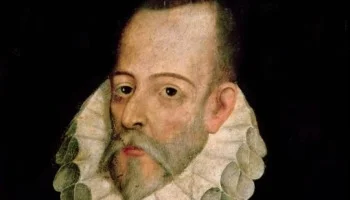Don Quijote de la Mancha by Miguel de Cervantes: summary and analysis of the book
The renowned work “Don Quixote of La Mancha,” whose original title is “El ingenioso hidalgo don Quijote de La Mancha,” is a novel belonging to the burlesque literary subgenre. It was penned by the Spanish writer Miguel de Cervantes Saavedra (1547-1616) and was published in two parts: the first volume in 1605 and the second in 1615.
Considered the first modern novel and a pinnacle of Spanish literature, “Don Quixote” parodies chivalric romances while presenting a critique of 16th-century society. Its dynamism is attributed to its humor and the use of popular sayings and proverbs.
The protagonists, Don Quixote and his squire Sancho Panza, stand at the forefront of the narrative. Don Quixote, an aristocrat from the upper-middle class, and Sancho Panza, his humble and less educated neighbor, form an unlikely pair.
Within Don Quixote’s imagination always resides Dulcinea del Toboso, an idealized love interest and the reason he perceives himself as a true knight-errant.
“Don Quixote of La Mancha,” the most universal book in Spanish literature, is one of those timeless novels that intersect with our lives at some point. Many readers regard it as the greatest book of all time.
But what truly is the book “Don Quixote” by Miguel de Cervantes? What does it signify? And what impact has it had since its publication?
Summary of the novel:
The book recounts the adventures and misadventures of a 50-year-old nobleman named Alonso Quijano, who decides to become a knight-errant like those depicted in his beloved chivalric books.
Don Quixote’s exploits are chronicled in two volumes, narrating three main escapades. The “First Part,” titled “El ingenioso Hidalgo Don Quijote de la Mancha,” consists of 52 chapters, encompassing the first and second outings.
The second volume, titled “El ingenioso Caballero Don Quijote de la Mancha,” comprises 74 chapters narrating the third outing.
How does the book “Don Quixote” begin?
This is the famous phrase that opens “Don Quixote of La Mancha”:
“In a village of La Mancha, the name of which I have no desire to call to mind, there lived not long since one of those gentlemen that keep a lance in the lance-rack, an old buckler, a lean hack, and a greyhound for coursing.”
First outing:
This section covers the initial eight chapters of the first volume. It marks the onset of Don Quixote’s supposed madness. The protagonist decides to become a knight-errant, setting out across Spain with his aged horse Rocinante.
Don Quixote ventures alone in pursuit of becoming dubbed a knight. Along the way, he unleashes his imagination, distorting the reality around him.
He mistakes an inn for a castle and the innkeeper for its lord, who, in jest, dubs him a knight. Subsequently, Don Quixote seeks adventures and aims to rectify injustices. One such incident involves addressing the abuse of power by a farmer named Juan Haldudo towards his servant Andrés.
Another escapade unfolds with some merchants from Toledo when Don Quixote endeavors to have them acknowledge Dulcinea del Toboso as the world’s most beautiful lady. Ultimately, Don Quixote gets beaten by the merchants.
However, his adventure is short-lived as neighbors find him wounded and take him home. There, his niece and housekeeper attribute his madness to the influence of books. Subsequently, a priest and a barber decide to burn some volumes in his library.
Finally, Don Quixote selects Sancho Panza as his squire, promising him governorship over an island if he accompanies him.
Second outing:
This encompasses the remainder of the first volume. It introduces Sancho Panza, who decides to bring along his donkey and accompany Don Quixote on his adventures after much insistence from the would-be knight-errant.
This part includes the famous episodes of mistaking windmills for giants, inns for castles, common women for princesses, and puppets for Moors. This segment is considered the most comedic and satirical in the entire work.
Third outing:
This constitutes the entirety of the second volume. It narrates the mishaps, jests, and deceits faced by these two adventurers. Here, the bachelor Sansón Carrasco endeavors to bring Don Quixote back to reason, eventually convincing him to renounce his fanciful adventures as a knight-errant and return to his homeland.
His initial attempt, recounted in Don Quixote’s second outing, involved disguising himself as the Knight of the Mirrors but ended in defeat.
In the second volume, Sansón disguises himself as the Knight of the White Moon and challenges Don Quixote to a duel, claiming that his maiden is more beautiful than Dulcinea. Don Quixote accepts the duel and, upon losing, fulfills his promise to abandon his exploits for a year.
Upon returning home, he falls ill and seemingly regains his sanity, apologizing for the troubles caused and requesting to make his will to die in peace.
Analysis of the novel:
Several fundamental aspects characterize Cervantes’s work, including its themes, the author’s use of colloquial language for the characters, and the impact of the book on our modern understanding of literature centuries after its publication.
Let’s delve into some of the most significant aspects of this novel, considered a pinnacle of universal literature.
Themes of the novel:
The richness of thematic content within Miguel de Cervantes’s work is apparent, spanning numerous subjects throughout its two volumes. Here are some themes embedded within its pages:
Literature:
The critique of existing literature, especially medieval chivalric romances, is evident and constitutes a continuous parody of this genre. How does Cervantes achieve this?
On one hand, Cervantes ridicules chivalric books by constructing a character whose madness is directly linked to reading such literature.
On the other hand, he accomplishes something unprecedented: for the first time, it’s the character who drives the action, not the other way around. That is, the characters take precedence over the events.
16th-century society:
The author also challenges the society of the time, one he was intimately familiar with.
The protagonist’s “madness” could serve as a vehicle to denounce the unequal, hierarchical, and corrupt reality of 16th-century Spain, amid the dawn of the Modern Age. He does this through characters from all social classes, showcasing popular customs and beliefs.
Love:
An essential prerequisite for any knight is to have a beloved. Therefore, Don Quixote, consumed by his madness, idealizes a woman to love. Dulcinea is a necessity for the protagonist as a knight, but she also serves as the driving force behind his adventures.
In this manner, Cervantes also ridicules courtly love, prevalent in chivalric romances.
Freedom:
The novel itself is a celebration of freedom. Cervantes used it to break free from conventions and laid the groundwork for contemporary novels.
The author utilized a “sane madman,” the protagonist of the book, to openly address taboos and critique without censorship. What could be freer for an author?
For Cervantes, this novel was perhaps synonymous with liberation.
Likewise, freedom is the driving force behind the protagonist and one of the most valued qualities:
“Freedom, Sancho, is one of the most precious gifts that heaven has bestowed upon men; no treasures that the earth holds buried or the sea conceals can compare with it; for freedom, as for honor, men can and ought to venture their lives, and, on the contrary, captivity is the greatest evil that can fall to the lot of man.”
Friendship:
Another prevalent theme in the novel is friendship, prominently seen in the relationship between Don Quixote and Sancho Panza. The bond between these two characters is unconditional, despite their stark differences.
Initially, it seems that nothing can unite them. However, despite being entirely disparate archetypes, they manage to merge.
Popular language in “Don Quixote”:
Another distinctive feature of Cervantes’s novel is that each character possesses a unique language style. That is, every character speaks or expresses themselves differently, with no two characters within the work manifesting the same manner of expression.
The language in the novel ranges from refined expressions to vulgar or colloquial ones. The most enriching linguistic aspect of the novel lies precisely in this colloquial register.
Especially through the character of Sancho Panza, Cervantes highlights certain proverbs deeply rooted in the popular culture of the time, particularly those spoken in the geographical area where the action unfolds. Some of these proverbs are still in use today, albeit with variations.
“Del dicho al hecho hay gran trecho.” (“There’s a long way from words to deeds.”)
Repercussions of the book “Don Quixote of La Mancha”:
More than 400 years after its publication, “Don Quixote of La Mancha” continues to captivate those who dare to immerse themselves in its pages. Cervantes’s work boasts immortality. What are the reasons for its survival through the ages?
On one hand, it marked a turning point in chivalric romances, becoming the first modern novel in literature.
On the other hand, it introduced a new approach to the genre, prioritizing the protagonism of characters over events.
Moreover, it is a highly critical work of society at the time. However, what Cervantes perhaps didn’t predict was that its astute commentary on the situation of that era would be a factor in its enduring legacy. The critique and thematic richness contained within the book are easily relatable to contemporary times.
Key Characters:
Don Quixote of La Mancha:
Originally named Alonso Quijano, he adopts the moniker Don Quixote. He is a hidalgo (a noble title inherited from his ancestors, not personally earned).
Don Quixote is a lean man around fifty years old, deeply enamored with chivalric books. His passion for these texts triggers his madness, leading him to believe he is a knight.
Don Quixote stands as the most universal character in Spanish literature, symbolizing justice and the wandering spirit.
Sancho Panza:
He is a Manchego laborer, the neighbor of Alonso Quijano, who is envisioned as a squire by Don Quixote during his adventures as a knight-errant.
In contrast to Don Quixote, Sancho Panza is a robust man of smaller stature. He embodies simplicity and naivety, representing the voice of reason amidst the protagonist’s madness.
Dulcinea del Toboso:
A fundamental requisite for being a true knight is having a lady love. Therefore, Dulcinea del Toboso is a character fabricated by Don Quixote within his chivalric tales. In reality, she is inspired by Aldonza Lorenzo, a local peasant.
According to the protagonist, Dulcinea is the most beautiful maiden in existence. However, she does not make an appearance in the novel but is frequently mentioned by Don Quixote.
Rocinante:
He is Don Quixote’s horse and faithful companion in adventures. Choosing his name was not an easy decision for the protagonist. The novel describes why he’s named Rocinante:
“For four days he tried to think of a name that would suit him and do him justice; for he had a name in his mind already for himself, and Rocinante seemed to him to express what he was looking for…”
Rucio:
This is Sancho Panza’s donkey, although this isn’t its official name. In reality, the novel doesn’t specify its name; Sancho simply refers to his donkey using the term “rucio,” synonymous with a donkey.
Influence of “Don Quixote” in art:
The universality of “Don Quixote” has rendered it a living literary work, present in other artistic disciplines almost since its inception. From its origin until today, the book has propagated through various forms of artistic expression.
Whether through visual arts depicting scenes from the novel or inspiring artists to create new works with “Quixotic” traits, “Don Quixote” has assured its immortality through art forms such as painting, music, cinema, theater, and literature. Some examples include:
In painting:
Numerous artists have attempted to portray Don Quixote through this medium. Salvador Dalí also offered his own interpretation of the ingenious hidalgo.
In music:
“Quixote” has been represented notably in European opera. However, the work of Cervantes has also inspired rock music. An example is the song “Niño siempre niño (Don Quijote en su delirio)” by the urban rock band Tragicomi-K.
In cinema:
Since the early days of film, adaptations of Don Quixote’s adventures have been attempted. Even today, there’s ongoing debate about which cinematic interpretation truly does justice to the novel.
In everyday language:
What does it mean when someone “is a quixote”? What does “dulcinea” signify? These questions demonstrate that “Don Quixote” hasn’t merely crossed geographical borders over the centuries but has transcended linguistic boundaries as well. The novel has introduced terms from its pages into everyday language.
Hence, when we refer to someone as a “quixote,” we actually imply that the person “has lofty ideals and fights for causes that, though noble and just, do not concern them directly.”
Moreover, when we allude to the meaning of “dulcinea,” we colloquially refer to a “beloved woman.” It can also denote something idealized or unattainable.
Biography of Miguel de Cervantes Saavedra:
Miguel de Cervantes Saavedra was born in Alcalá de Henares (Madrid) in 1547 and passed away in Madrid on April 22, 1616.
He was the son of a physician named Rodrigo de Cervantes and Leonor de Cortinas. During his youth, he studied in various cities across Spain (Madrid, Valladolid, Salamanca, among others), due to his family’s migratory movement in search of better economic prospects.
In 1569, he traveled to Rome due to legal issues, and in 1571, he participated in the famous Battle of Lepanto, where his left hand suffered an injury.
In 1575, on his way back to Spain, he was imprisoned with his brother and taken to Algiers. In 1580 he managed to return to Spain after several attempts to escape and thanks to the payment of a ransom by his family.
In December 1584 he married Catalina de Palacios de Salazar. A year later he published the novel La Galatea. It was not until he was 57 that he published Don Quixote de la Mancha. Ten years later, in 1615, he published the second part called El ingenioso caballero don Quijote de la Mancha.








